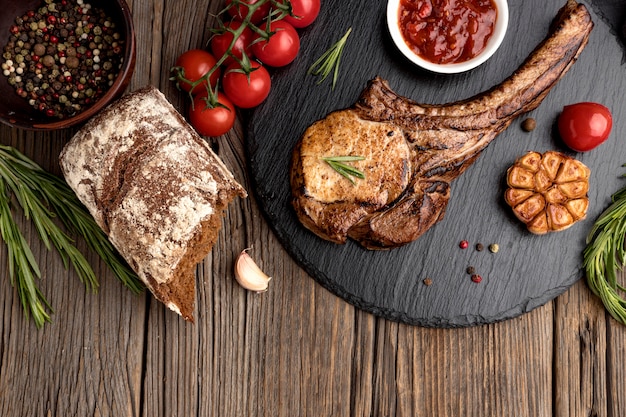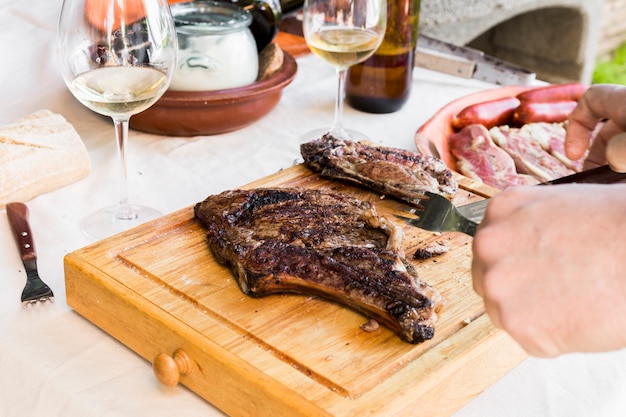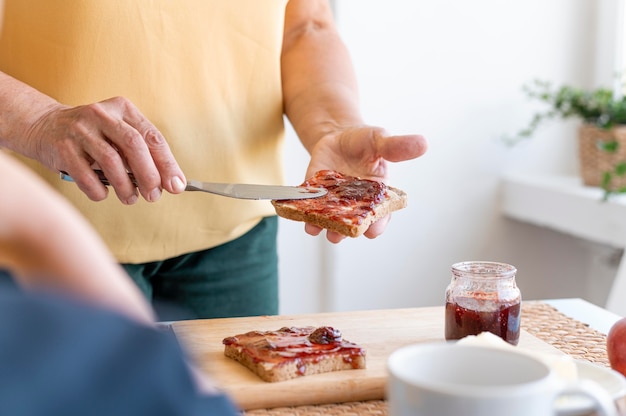Alright, let's talk steak! Now, I know what you're thinking: "Steak? That's easy, just slap it on the grill and call it a day." But trust me, my friend, there's a whole world of juicy, flavorful steak out there waiting to be explored, and a bone-in ribeye is the perfect place to start. It's the king of cuts, a majestic piece of meat that deserves to be treated with respect and cooked to absolute perfection.
I've been grilling, pan-searing, and even reverse-searing ribeyes for years, and let me tell you, there's nothing quite like that first bite of a perfectly cooked steak. It's a symphony of textures and flavours – a tender, juicy interior, a delightful char on the outside, and a richness that just melts in your mouth.
So, grab your apron, sharpen your knives, and let's embark on this culinary journey together. We'll cover everything from selecting the perfect ribeye to mastering the art of cooking it to your desired level of doneness, and even some tips and tricks to elevate your steak game. We'll also explore the fascinating science behind why these techniques work, so you can truly understand the art of cooking the perfect steak.
(Part 1)
choosing the right ribeye: A Guide to Picking the Perfect Cut

Let's start with the foundation of your steak masterpiece: the ribeye itself. There are a few things to keep in mind when selecting your perfect cut.
The Cut: Bone-In for the Win
I'm a huge fan of bone-in ribeyes. Why? Well, that bone adds a whole lot to the experience! Firstly, it provides a flavour boost, adding a subtle depth and richness that simply can't be replicated with boneless cuts. Secondly, the bone helps to retain moisture during cooking, resulting in a more tender and juicy steak. And let's not forget the primal satisfaction that comes with gnawing on that bone at the end! It just adds an extra layer of enjoyment to the whole experience.
The Marbling: Key to Juiciness
Look for a ribeye that's well-marbled, meaning it has streaks of fat running throughout the meat. Fat is where the flavour lies, my friend. The marbling contributes to a deliciously tender and juicy steak, so don't be afraid to choose a cut with a good amount of it.
The Quality: Prime or Choice for Supreme Flavor
It's worth investing in a quality piece of meat for this. In the United States, look for a ribeye that's graded "Prime" or "Choice" for the best flavour and tenderness. These grades indicate that the meat meets specific standards for marbling and quality. If you're in the UK, ask for a ribeye that's been "aged" for at least 21 days – this will develop a deeper flavour and more tender texture.
The Thickness: A Matter of Even Cooking
Aim for a ribeye that's at least 1.5 inches thick. This will allow you to cook it to your desired level of doneness without overcooking the outside. If the steak is too thin, it'll cook too quickly, potentially leading to a dry and chewy result.
(Part 2)
Preparing Your Ribeye for Success

You've got your perfect ribeye in hand. Now it's time to prep it for cooking.
Pat it Dry: Unlocking a Beautiful Sear
The first step is to pat the ribeye dry with paper towels. This might seem like a simple step, but it's crucial. A damp surface will hinder the formation of a beautiful, crispy sear. When the steak hits a hot pan or grill, the water on the surface will steam, preventing the maillard reaction (the chemical process responsible for browning and flavour development) from happening efficiently.
Seasoning: Simple is Best
Now, for seasoning, I like to keep it simple. Salt and freshly ground black pepper are all you really need. Season generously on both sides, and don't be afraid to get a good crust going. The salt will help draw out moisture from the steak, which will then be reabsorbed during cooking, creating a more flavourful and tender result.
Let it Rest: Ensuring Even Cooking
Before you start cooking, let the steak come to room temperature for about 30 minutes. This might sound counterintuitive, but it's essential for even cooking. A cold steak placed on a hot surface will shock the outside, causing it to cook faster than the inside, leading to uneven doneness. Allowing the steak to reach room temperature ensures that it cooks evenly from core to crust.
(Part 3)
Cooking Your Ribeye: Mastering the Techniques

Now comes the fun part: cooking the ribeye! We'll explore three popular methods: pan-searing, grilling, and reverse-searing.
Pan-Searing: A Classic and Versatile Technique
Pan-searing is my go-to method for ribeye. It's fast, simple, and delivers a beautiful crust.
- Heat a heavy-bottomed pan over high heat. Cast iron is ideal, as it retains heat beautifully, but any heavy pan will do.
- Add a tablespoon or two of oil to the pan. I use a combination of olive oil and grapeseed oil, but any high-heat oil will work.
- Once the oil is shimmering hot, sear the ribeye for 2-3 minutes per side. You'll know it's ready when you see a nice, crispy crust forming. The intense heat of the pan creates a maillard reaction, giving the steak a delicious browned surface.
- Reduce the heat to medium and continue cooking for another 2-3 minutes per side. This will cook the steak to medium-rare, but you can adjust the cooking time to your desired level of doneness.
- Remove the steak from the pan and let it rest for 5-10 minutes before slicing and serving. This allows the juices to redistribute, making for a juicier, more flavorful steak.
Grilling: Perfect for Summertime Steak
Grilling is another fantastic option for ribeye, especially on a warm summer day.
- Preheat your grill to high heat. Aim for around 500°F for a nice, searing effect.
- Oil the grill grates to prevent sticking.
- Place the ribeye on the hot grill and cook for 2-3 minutes per side. Again, you're aiming for a good sear.
- Reduce the heat to medium and continue cooking for another 2-3 minutes per side. You can check for doneness by using a meat thermometer.
- Remove the steak from the grill and let it rest for 5-10 minutes before slicing and serving.
Reverse-Searing: The Science of Tenderness and Crispness
reverse searing is a method that involves cooking the steak low and slow in the oven before finishing it on the grill or pan. This results in a steak that's perfectly cooked throughout and has a beautiful, crispy crust.
- Preheat your oven to 250°F.
- Place the ribeye on a baking sheet and cook for 1-2 hours. Check the internal temperature with a meat thermometer – it should reach about 120°F for medium-rare.
- Remove the steak from the oven and let it rest for 10 minutes.
- Heat a grill pan or heavy-bottomed pan over high heat.
- Sear the steak for 1-2 minutes per side, or until you get a nice crust.
- Remove the steak from the pan and let it rest for another 5-10 minutes before slicing and serving.
(Part 4)
The Doneness Factor: A Guide to Perfecting Your Steak
Now, let's talk about the most important part: the doneness of your ribeye.
Understanding the Temperatures
Here's a quick guide to the different levels of doneness and their corresponding internal temperatures:
| Doneness | Internal Temperature (°F) |
|---|---|
| Rare | 125-130°F |
| Medium-Rare | 130-135°F |
| Medium | 135-140°F |
| Medium-Well | 140-145°F |
| Well-Done | 145-150°F |
doneness testing Methods: Beyond the Thermometer
You can test the doneness of your steak using a meat thermometer, which is the most accurate method. But if you don't have one, here are some other methods:
- The Finger Test: This method is based on the texture of your palm. Press the middle of your palm with your index finger – that's the feel of rare. Press your thumb into your palm – that's medium-rare. The rest is up to you.
- The Touch Test: Gently touch the steak – if it feels firm and springy, it's medium-rare. If it feels firm and has a slight give, it's medium. If it feels very firm, it's well-done.
My Personal Preference: Medium-Rare for Maximum Flavor
Personally, I prefer my ribeye medium-rare. It's juicy, tender, and full of flavour. I find that anything beyond medium-rare can get a bit dry, but hey, that's just my opinion.
(Part 5)
Resting and Slicing: Unlocking the Juiciest Steak
Once your ribeye is cooked, don't be tempted to slice it immediately. It needs to rest for 5-10 minutes. This might seem like an unnecessary step, but it's crucial for a delicious, juicy steak.
The Science of Resting
When a steak is cooked, the juices get pushed towards the center. As the steak cools, the juices redistribute more evenly throughout the meat. This is why a rested steak is much more juicy and flavorful than one that's cut immediately.
Slicing Tips: Cut Against the Grain for Tenderness
After resting, use a sharp knife to slice the ribeye against the grain. This means cutting across the muscle fibers, making for easier chewing and a more tender bite. Slice the steak about 1/2 inch thick, allowing for a balance between satisfying chew and juicy tenderness.
(Part 6)
Sauces and Sides: Elevating Your Steak Experience
Now, for the finishing touches. A good sauce can elevate a ribeye to new heights.
My Favourite Sauce: Red Wine Reduction for a Rich and Complex Flavor
My go-to sauce for ribeye is a simple red wine reduction. It's rich, flavorful, and complements the steak beautifully. Here's how to make it:
- Heat a saucepan over medium heat.
- Add a cup of red wine and bring it to a simmer.
- Cook the wine until it reduces by half, about 10-15 minutes. The wine will thicken and intensify in flavor as it simmers.
- Stir in a tablespoon of butter and a pinch of salt and pepper. The butter adds richness and a velvety texture to the sauce.
- Serve warm over the steak.
Sides for Your Steak: Complementary Flavors and Textures
Now, let's talk sides. Here are a few of my favourites:
- Roasted Potatoes: Crispy on the outside, fluffy on the inside, roasted potatoes are a classic steak companion.
- Garlic-roasted asparagus: The sweetness of the asparagus complements the richness of the steak beautifully.
- Creamed Spinach: A rich and creamy side dish that's perfect for soaking up the steak juices.
(Part 7)
Tips and Tricks: Level Up Your Steak Game
Here are some tips and tricks to help you take your ribeye to the next level.
Use a Meat Thermometer: Accuracy for Perfect Doneness
A meat thermometer is your best friend when it comes to cooking steak. It takes the guesswork out of doneness and ensures that your steak is cooked to perfection.
Don't Overcrowd the Pan: Maintain Even Heat
If you're pan-searing or grilling, make sure you don't overcrowd the pan. This will cause the temperature to drop, and your steak won't get a proper sear. Cook the steaks in batches if necessary.
Don't Press on the Steak: Let It Cook Naturally
Resist the urge to press down on the steak while it's cooking. This will only squeeze out the juices and make your steak dry. Let the steak cook naturally, and trust the heat to do its job.
Invest in a cast iron pan: The Ultimate Tool for Steak
A cast iron pan is a must-have for any serious steak cook. It distributes heat evenly and helps to create a beautiful crust. Cast iron is also known for its ability to retain heat, ensuring a consistent sear and even cooking.
(Part 8)
FAQs: Your Steak Questions Answered
Here are some common questions about cooking ribeye, and their answers.
What if my ribeye is too thick?
No problem! If you have a particularly thick ribeye, you can cook it in the oven first to get it to your desired level of doneness, then finish it off on the grill or pan for a beautiful sear. This method allows for a more even cook throughout the steak, preventing the outside from getting overcooked before the center reaches the desired temperature.
What should I do with the leftover ribeye?
Leftover ribeye is fantastic in a salad or on a sandwich! Just slice it thinly and add it to your favorite dish. You can also add it to a pasta dish, stir-fry, or even a breakfast burrito!
Can I freeze ribeye?
Yes, you can freeze ribeye. Wrap it tightly in plastic wrap and aluminum foil and store it in the freezer for up to 3 months. The freezing process can affect the texture, so it's best to thaw the steak slowly in the refrigerator overnight before cooking.
How do I tell if a ribeye is fresh?
Look for a ribeye that's brightly colored, has a firm texture, and smells fresh and clean. Avoid ribeye that has a dull color, a slimy texture, or an off-putting odor.
What is the best way to store ribeye?
For best results, store ribeye in the refrigerator for up to 5 days. Place it on a plate and cover it tightly with plastic wrap. This will help prevent the steak from drying out and keep it fresh for longer.
(Part 9)
The Art of Enjoying a Perfectly Cooked Ribeye
Your steak is cooked to perfection, it's resting, and you're ready to savor it. Here are a few tips to elevate the enjoyment of your steak experience.
The Presentation: A Feast for the Eyes
Let's be honest, food looks best when it's presented well. Place your perfectly cooked ribeye on a beautiful platter or plate, and arrange your sides artfully around it. A little garnish like fresh parsley or rosemary can add a touch of elegance and visual appeal.
The First Bite: A Moment to Savor
Now, here comes the moment of truth. Take a deep breath, grab your fork, and dive into that first bite. The perfect ribeye should have a beautiful crust, a juicy, tender interior, and a rich, flavorful experience.
The Savoring: A Culinary Journey
Don't rush it. Savor each bite, letting the flavors dance on your tongue. A good ribeye is meant to be enjoyed, not devoured. Take time to appreciate the texture, the char, and the rich, meaty flavor.
(Part 10)
Conclusion: Embark on Your steak mastery
There you have it, my friends! The ultimate guide to cooking bone-in ribeye steak to perfection. Remember, it's all about choosing the right cut, preparing it properly, cooking it to your desired level of doneness, and enjoying it with your favorite sides.
So, the next time you're craving a truly exceptional steak experience, pick up a beautiful bone-in ribeye and put these tips to the test. Trust me, your taste buds will thank you. And who knows, you might just become the next steak guru in your circle!
Everyone is watching

How to Cook Frozen Lobster Tails Perfectly: A Step-by-Step Guide
RecipesLobster. Just the word conjures up images of lavish meals, special occasions, and a taste of luxury. But let's...

Pigs in a Blanket Cooking Time: How Long to Bake for Perfect Results
RecipesAh, pigs in a blanket. Just the name conjures up images of those delightful little parcels of crispy pastry en...

Pork Fillet Cooking Time: How Long to Cook It Perfectly
RecipesPork fillet, or tenderloin as it's sometimes called, is a real favourite in our house. It's so versatile, and...

The Ultimate Guide to Tender, Juicy Pulled Pork
RecipesRight, let's talk pulled pork. It's one of those dishes that just screams "comfort food," doesn't it? I mean...

The Ultimate Guide to Cooking Delicious Frankfurters
RecipesLet's face it, we all love a good frankfurter. It's a classic, simple, and always satisfying. But let's be rea...
